The development of renewable energy is an established national policy in China, and it is also the key to ensuring economic stability and sustainable development. About 80% of the world's power stations use thermal energy to generate electricity. However, the average efficiency of these power stations is only ~30%, and ~15TW of heat is lost to the environment each year. If this part of energy can be recycled, the current outstanding energy can be effectively mitigated. With environmental issues. The thermoelectric conversion technology with the thermoelectric material as the core can directly convert the energy of “heat†and “electricity†in two different forms without relying on any external force, and has received extensive attention from the scientific community and the industrial community. In particular, in recent years, a new generation of smart micro-nano electronic systems represented by wearables and implantable devices are urgently needed to develop microwatt-milliwatt-level self-powered technologies instead of traditional rechargeable batteries to meet their requirements for miniaturization and high density. Technical requirements for high stability and reliability development. The thermoelectric material can utilize the temperature difference between the human body temperature and the surrounding environment to generate electricity, and thus becomes an effective solution for the self-powered technology of the portable intelligent electronic device.
On the one hand, compared with other types of energy conversion, thermoelectric technology has a low conversion efficiency of only ~10%, which severely restricts the development of the thermoelectric technology industry. The performance of thermoelectric materials can be measured by the thermoelectric value (zT):
zT=S2σT/(κe + κL)
Where S is the Seebeck coefficient of the material, σ is the conductivity, T is the operating temperature, and κe and κL are the thermal conductivity of the electron and the phonon, respectively. Due to the limitation of the intrinsic physical properties, it is determined that the various parameters of the zT value are related to each other, making it difficult to greatly improve the coefficient of merit of thermoelectric materials.
On the other hand, in order to maintain the temperature difference and make full use of thermal energy to generate electricity, thermoelectric materials/devices need to be closely attached to the surface of the heat source. However, in practice, both the human body surface and the heat source pipe have geometric surfaces with complex curvature changes. Traditional inorganic thermoelectric materials, due to their inherent brittleness, cannot meet the requirement of closely conforming to the surface of the heat source with varying curvature, and the thermal energy loss between the heat source and the thermoelectric material/device is in a relatively high range. In addition to the thermoelectric value of the thermoelectric material itself, the loss of heat energy caused by the poor contact between the heat source and the thermoelectric material becomes one of the key factors restricting the development of the existing thermoelectric technology.
Therefore, it has been explored to increase the Seebeck coefficient through scaling effect, alloying, interfacial energy barrier regulation, etc., and to design methods that use multi-scale imperfections to disperse phonons and suppress thermal conductivity to improve thermoelectric conversion performance, and to develop new high-performance flexible thermoelectric materials. Device preparation technology, research on the mechanism of improving the intrinsic brittleness of inorganic thermoelectric materials and other issues have become global difficulties and hot issues in this field.
Institute of Metal Research, Chinese Academy of Sciences Researcher at the Shenyang National Laboratory for Materials Science (Yogai) Research Group Qi Kaiping is dedicated to designing and fabricating thermoelectric thin film materials and devices with highly ordered microstructures from the atomic scale. The physical vapor deposition technique was used to control the adjacent grains to tilt grain boundaries at a small angle, and Bi2Te3 thermoelectric thin films with a high degree of textured orientation in both in-plane and out-of-plane directions were prepared for the first time. Studies have shown that small-angle tilting grain boundaries can suppress carrier scattering to enhance in-plane electrical conductivity, while maintaining the scattering of phonons to reduce thermal conductivity, and significantly improve thermoelectric conversion performance. It is a preparation of high-performance Bi2Te3 thermoelectric thin film materials. The effective method.
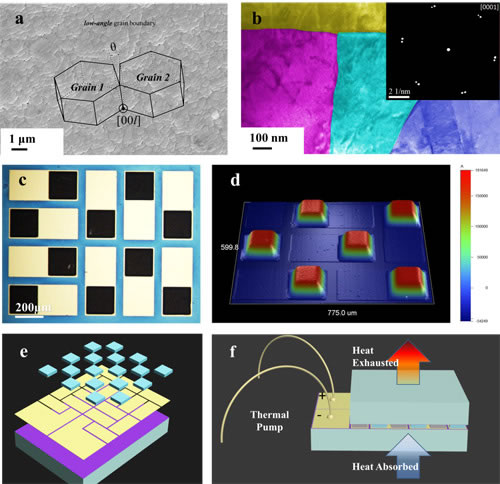
Figure 1. SEM (a), TEM (b) microstructure analysis and optical microscopy analysis of a thermoelectric thin-film cryocooler with non-equilibrium magnetron deposition to prepare Bi2Te3 thin-angular grain boundaries (c), 3D profile analysis of a profiler (d) Schematic diagram of chiller structure (e)-(f)
Based on the above technology, combined with the high-precision microbeam laser processing platform designed and constructed by the research team, Bi2Te3 alloy thin film microrefrigerator was developed. The thermoelectric pair thickness is ~25μm, the minimum in-plane size is ~200×200μm, and the micro-area cooling flux can be Up to ~40W/cm2. The device has a wide range of application prospects in the field of microsystem thermal management, such as CPU chip fixed-point heat dissipation, micro laser diode temperature control. This work achieved domestic technological breakthroughs in the field of preparation and processing of thermoelectric film microrefrigerators, and won the “Excellent Wall Materials Exhibition for Thermoelectric Materials and Devices Subcommittee†at the 2017 China Material Conference. It applied for 1 patent for invention and authorized 2 items.
For the first time, the team used unbalanced magnetron sputtering technology to fabricate a bismuth telluride composite thermoelectric film material with a micron-to-nano multi-scale pore structure based on cellulose paper, as shown in the figure below.
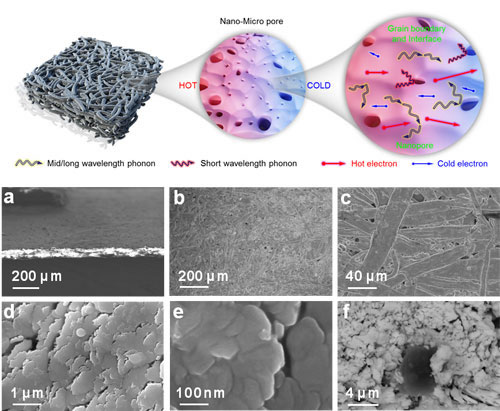
Figure 2. Multi-scale pore structure design schematic and SEM structural characterization of cellulose/ Bi 2 Te 3 composite flexible thermoelectric material
Studies have shown that, due to the characteristics of unbalanced magnetron sputtering, the Bismuth Telluride film is tightly bound to the cellulose interface, and the nominal thickness of the deposited film can reach several tens of micrometers, which can effectively reduce the internal resistance of the thin film device and improve the output efficiency of thermoelectric conversion. The unique network structure of cellulose/Bi2Te3, the multi-scale pore structure and Bi2Te3 film size effect give the cellulose/Bi2Te3 composite material a good bending flexibility; the multi-scale pore structure in the composite thermoelectric film can efficiently scatter phonons and reduce thermal conductivity. The rate value is close to the theoretical minimum thermal conductivity of Bi2Te3; an intrinsic oxide layer exists on the surface of the Bi2Te3 film. When the carrier is transported between the Bi2Te3 films on the adjacent cellulose surface, the oxide layer at the interface can scatter and filter the low energy carrier. Flows significantly increase the Seebeck coefficient. Therefore, the ZT value of the thermoelectric properties of cellulose/Bi2Te3 composites from room temperature to 473K can reach 0.24~0.38, and it is expected to further improve the carrier concentration. Using a high-precision microbeam laser platform, the composite flexible thermoelectric material was cut and device integrated to demonstrate and validate a flexible thermoelectric “generator†based on the composite material. This work has provided new ideas and solutions for the exploration of new high-performance flexible thermoelectric materials, opening up a new direction for the practical development of flexible thermoelectric devices.
The research work has been supported by the National Natural Science Youth Fund, the Fund of the Face, and the "Hundred Talents Program" of the Chinese Academy of Sciences.
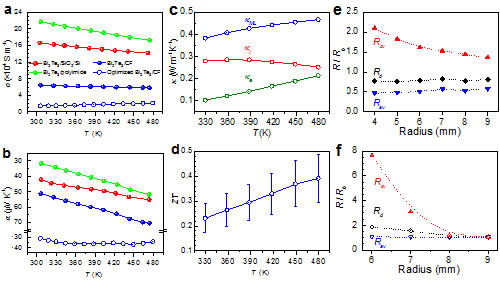
Figure 3. Thermoelectric Properties (ad) and Flexural Bending Properties of Cellulose/ Bi 2 Te 3 Composites
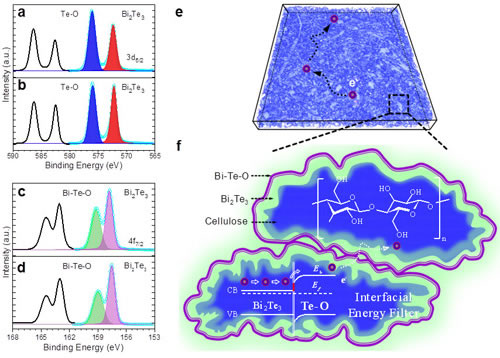
Figure 4. XPS analysis of multi-scale pore tellurium tellurium composites and 3D nano-X-ray imaging analysis of composite thin-film materials and interface energy barrier filtering low-energy carrier effects
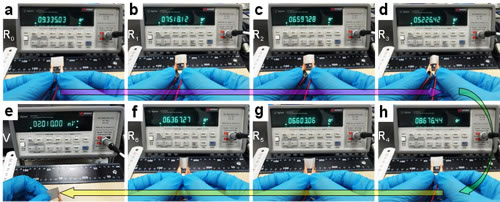
Figure 5. In-situ bending electrical performance testing of composite flexible thermoelectric materials and the use of human body temperature and ambient temperature differential thermal voltage
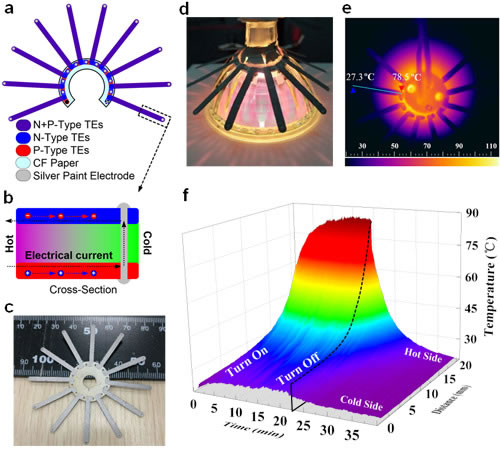
Figure 6. Schematic diagram of the structure design of a flexible thermoelectric "generator" device and the demonstration of recycling waste heat power generation demonstration
Medical Caster(Twin Wheel)
Medical Caster(Twin Wheel)
Medical Caster(Twin Wheel)
Ningbo Mywin Caster Co., Ltd. , https://www.mywin-caster.com
